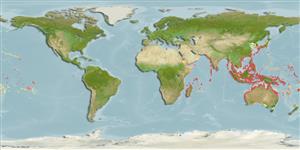Common names from other countries
Classification / Names / Names
आम नाम | उपशब्द | Catalog of Fishes (gen., sp.) | ITIS | CoL | WoRMS
Environment: milieu / climate zone / depth range / distribution range
पारिस्थितिकी
; खारा; गहराई सीमा 0 - 20 m (Ref. 101198). Tropical, preferred 27°C (Ref. 107945); 46°N - 39°S, 26°E - 134°W (Ref. 106948)
Indo-Pacific.
Length at first maturity / आकार / वज़न / Age
Maturity: Lm ?, range 2 - 2.1 cm Max length : 9.0 cm SHL पुल्लिंग / अलिंग; (Ref. 348); common length : 6.0 cm SHL पुल्लिंग / अलिंग; (Ref. 348); अधिकतम सूचित उम्र: 12 वर्षो (Ref. 126573)
Shell equivalve, thick and solid, ovate, strongly inflated, slightly longer than high and feebly inequilateral. Umbones strongly protruding, cardinal area rather large. About 18 radial ribs (15 to 20) with wide interstices at each valve; ribs stout and distinctly rugose, bearing regular, often rectangular nodules. Periostracum rather thin and smooth. Internal margins with strong crenulations corresponding with the external radial ribs. No byssal gape. Colour: outside of shell white under the yellowish brown periostracum. Inner side white, often tinged yellow towards the umbonal cavity.
This represents the most important commercial ark (Ref. 348).
Members of the class Bivalvia are mostly gonochoric, some are protandric hermaphrodites. Life cycle: Embryos develop into free-swimming trocophore larvae, succeeded by the bivalve veliger, resembling a miniature clam.
Poutiers, J.M. 1998. (Ref. 348)
IUCN Red List Status (Ref. 130435: Version 2024-1)
CITES status (Ref. 108899)
Not Evaluated
Not Evaluated
Threat to humans
Harmless
Human uses
मात्स्यिकी: व्यापारिक
FAO - जलीयकृषि: production; मात्स्यिकी: landings, species profile | FishSource | Sea Around Us
साधन
इंटरनेट स्रोत
Estimates based on models
Preferred temperature
(Ref.
115969): 21.8 - 29.3, mean 28.4 (based on 3701 cells).
लौटाव
ऊंचा, न्यूनतम जनसंख्या दुगनी समय अवलागत 15 महीने। (K=0.54-4.34; tm=0.6; tmax=12).
Prior r = 0.85, 95% CL = 0.56 - 1.28, Based on 2 data-limited stock assessments.
Vulnerability
Low to moderate vulnerability (28 of 100).
